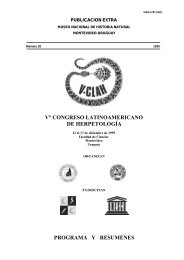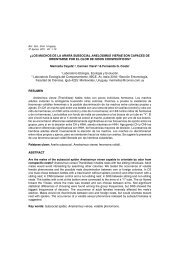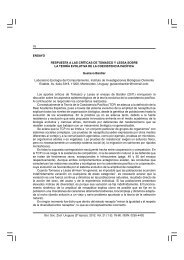Primer Congreso Uruguayo de Zoología - Sociedad Zoológica del ...
Primer Congreso Uruguayo de Zoología - Sociedad Zoológica del ...
Primer Congreso Uruguayo de Zoología - Sociedad Zoológica del ...
Create successful ePaper yourself
Turn your PDF publications into a flip-book with our unique Google optimized e-Paper software.
MALACOFAUNA LÍMNICA EM UM TRECHO DO RIO CHAPECÓ, SANTA CATARINA,BRASILSouza-Franco G.M., Magro J.D. & Franco R.M.Universida<strong>de</strong> Comunitária da Região <strong>de</strong> Chapecó, Brasil. gfranco@unochapeco.edu.brA região da bacia do rio Chapecó era originalmente recoberta com vegetação característica do bioma Mata Atlântica,possuindo altíssima riqueza e diversida<strong>de</strong> biológica. O objetivo do trabalho foi caracterizar a malacofauna em umtrecho do rio Chapecó, entre os municípios <strong>de</strong> Coronel Freitas e Águas Frias, Santa Catarina, Brasil. As amostras (emtriplicata) do substrato foram realizadas em <strong>de</strong>zembro/2008 m em cinco pontos e outubro/2009 recolhidas comsuber com malha <strong>de</strong> 300 (P1, P2, P3, P5 e P6). As amostras foram pré-triadas em jogo <strong>de</strong> peneiras <strong>de</strong> abertura <strong>de</strong> 2; 1e 0,5mm, respectivamente. Os invertebrados retirados nas duas primeiras malhas foram fixados em álcool 70 o GL, e osedimento retido nas duas últimas peneiras foi fixado em formol 4% e neutralizados com carbonato <strong>de</strong> cálcio. Sobmicroscópio estereoscópico, em laboratório foram realizadas a triagem, contagem e i<strong>de</strong>ntificação dos organismos. Ai<strong>de</strong>ntificação taxonômica dos organismos foi realizada com auxílio <strong>de</strong> chaves e comparação com pranchas ilustrativas.Foram coletados 376 indivíduos da malacofauna pertencente a nove táxons distribuídos entre as classes Bivalvia eGastropoda. A maior abundância relativa foi registrada para a classe Bivalvia (76,1%), sendo predominante nas duascampanhas. Em relação a distribuição temporal, a maior abundância foi em <strong>de</strong>zembro (200 ind., 53,2%), compredomínio <strong>de</strong> Corbicula fluminea Müller (1774) (87 ind.) seguido <strong>de</strong> Pomacea sp. Perry (1811) (72 ind.). Emoutubro/2009 Pisidium sp. Pfeiffer (1821) foi dominante, representando 92,6% da abundância, enquanto C. flumineaesteve ausente. Contudo, no mês <strong>de</strong> outubro ocorreu gran<strong>de</strong> volume <strong>de</strong> chuvas, o que po<strong>de</strong> ter contribuído com amaior ocorrência <strong>de</strong> Pisidium sp. que é associado a estação chuvosa na literatura. Ainda, a presença da espécieexótica, Corbicula fluminea nos alerta para a necessida<strong>de</strong> <strong>de</strong> programas <strong>de</strong> controle e manejo, por competir com asnativas.SPATIAL AND TEMPORAL PATTERNS OF TRICHOPTERA ASSEMBLAGES OF MOUNTAINSTREAMS IN NEOTROPICAL REGION: ENVIRONMENTAL RELATIONSHIPSSpies, M.R. 1,2 & C.G. Froehlich. 21 Faculda<strong>de</strong> <strong>de</strong> Ciências e Letras, UNESP – Campus Assis - SP, Brasil. 2 Faculda<strong>de</strong> <strong>de</strong> Filosofia Ciências <strong>de</strong> Ribeirão Preto – USP. SP,Brasil.The aims of the present study were: i) to i<strong>de</strong>ntify and to quantify the contribution of explanatory environmentalvariables on spatio-temporal distribution patterns of Trichoptera larvae in streams of Serra da MantiqueiraSoutheastern Brazil; ii) to test the occurrence of seasonality of most abundant genera recor<strong>de</strong>d. Trimonthlysamplings were done in six streams of the Campos do Jordão State Park. Were checked up on water physiochemistryvariables (pH, O 2 , electric conductivity, turbidity, slope, width, <strong>de</strong>pth, water speed and discharge), food availability(biomass and chlorophyll of periphyton and circulate, retained and <strong>de</strong>posited organic matter) and climatic variables(rainfall and temperature). The canonical ordination (Redundancy analysis) i<strong>de</strong>ntified physical structure variablesrelated to hydrological or<strong>de</strong>r and food availability as the main explanatory variables responsible by spatial frameworkof Trichoptera assemblages studied. The minimal temperature was the main explanatory variable related to thetemporal framework observed. The variance partitioning showed that the purely spatial variables explained 53.9% ofthe variance and additional 10% were explained by the interaction between temporal and spatial variables. Only 4.6%were explained by the purely temporal variables, while 31.5% remained unexplained. The circular analysis confirmedthe low temporal framework in Trichoptera larvae assemblages in Serra da Mantiqueira streams, since mostabundant genera presented low seasonality. These results indicated that the framework of the Trichopteraassemblages studied is primarily explained by local factors, but the importance of regional variables could not berejected. Financial support: BIOTA/FAPESP and FAPESP.266 <strong>Primer</strong> <strong>Congreso</strong> <strong>Uruguayo</strong> <strong>de</strong> <strong>Zoología</strong>







